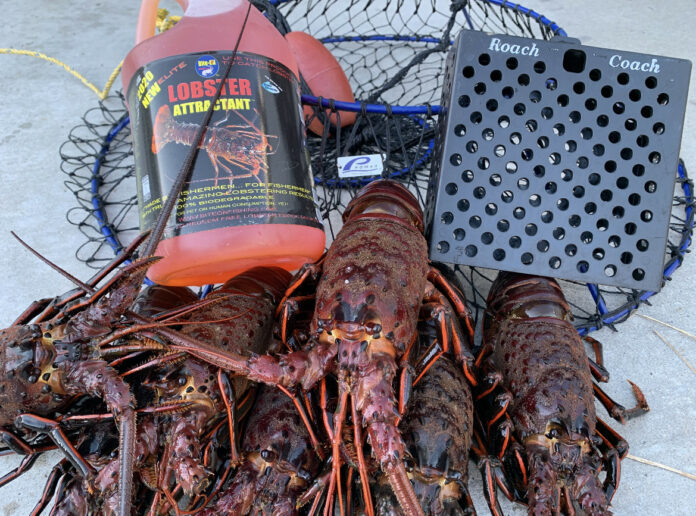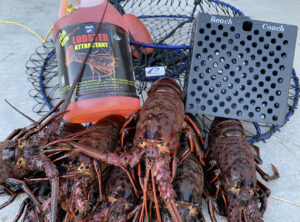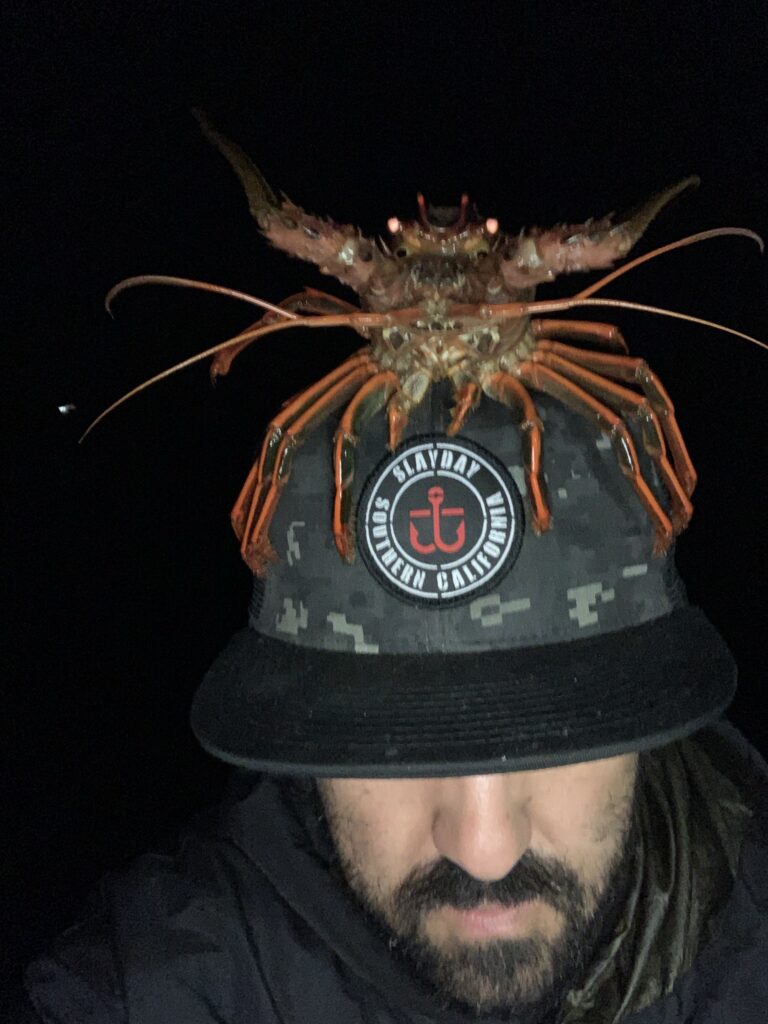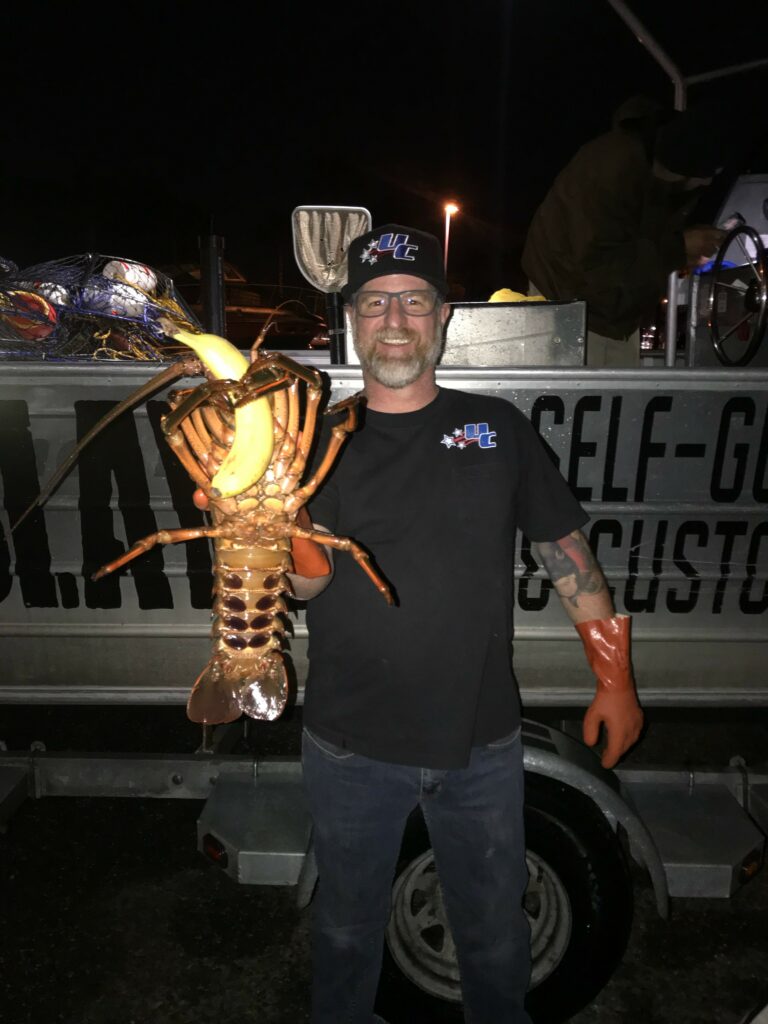
BY RYAN CANDELARIA
We’ve all been there – the hoop netter’s nemesis of the Southern California lobster bite. You and your crew spend sundown into the early morning dropping set after set, pulling up dry pot after dry pot, only to give each other that frustrated look at 1:30 in the morning, “Guys. I think it’s time to call it.”
If you’ve been hooping at all, you know the feeling. A lot of prep work goes into hoopnetting for the evening, and even when conditions seem right: bait seems fresh, current seems running, moon phase is favorable, the skunk or near-skunk can happen.
Using the basic law of marginal gains, we’d like to suggest small, yet effective, changes you can make in your hoopnetting plan, that should help you get those little red demons crawling in your pots. Here’s what you need to look out for and focus on to get those limits.
Bait
This is the simplest change you can make. Whether you’re hooping down in San Diego Bay, off Dana Point, or enjoying the massive hunting grounds in Long Beach Harbor, fresh live bait is readily available to all of us. A $40 full scoop will get you about 3/4 of a 5-gallon bucket, and should get you through the first few sets.
Refrain from obliterating and smashing your bait; cover your bucket, and allow them to stop their death dance. A few small cuts in each sardine is enough, and the same goes for mackerel. Mackerel simple need a stab or two, as our CA Spiny Lobster will pick-up the small pulses of electro-magnetic energy emitted from a dying fish.
If you have the time or resources, freshen your bait every 2-3 drops, and recycle your used bait as chum for mackerel schools on the sabiki. If you need to hold-on to your bait due to time or funds, try freshening your bait up with BiteOn Lobster and Crab Attractant. This stuff can be a game changer if all you have access to is old or frozen bait.
Bait holders
They’re cute and friendly, but the California sea lion has absolutely changed the way we present our bait here in SoCal. Gone are the days of wire cages and tie-in bait baskets. It is critical to spend the money (or make your own) seal-proof cages.

Some industry-standard designs include: Roach Coach Bait Systems, Promar cylindrical seal-proof tubes, and capped 3″-5″ black PVC DIY systems. There are several key elements to an effective, anti-seal bait holder that you need to know.
Use black only if possible, make sure your holes are big enough for lobster feeding (nothing smaller than 1/2″ in diameter), and secure them WELL onto your lower ring of your rigid hoopnet. Zip ties work great, but aluminum carabiners are cheap, and they offer an extra layer of anti-seal design.
Line management
Most local hoopnetters are realistically fishing in 10- to 50-feet of water and unless you’re using weighted line, this can cause a prop hazard if extra line isn’t properly managed. Most

hoopnet kits come with 75’ of line.
A quick and easy fix is to attach a 16 oz torpedo weight to the end of your line with a zip tie. This simple addition to each hoopnet set-up will allow your extra line to travel down to the sea floor with your net, and will keep your lines parallel all evening, even with strong current.
This makes retrieving your surface float much easier, and almost eliminates prop foul-ups. Promar and Lead Masters make a clip-on system, and they work well, but in this day-and-age, budget is king, we know.
Soak times and set-checks
Just like Captain Dave Hansen says, “Yeah, I know. Your brother’s sister’s aunt’s uncle soaks his hoops for an hour each time and gets limits every time he goes out, but here’s the right way.”
That being said, shorter soak times are more effective in SoCal than lengthy multi-hour soaks. Our first sets of the night, right around/before sundown, are for 30-45 minutes, and just get shorter as the evening goes on. If you’re using 10 hoops (CA maximum amount on a single vessel) check hoop #1 as you toss-over hoop #10.
A soak time of 20-40 minutes is PLENTY if using fresh bait, and the bugs will let you know if they’re crawling in an area. If you find a bug, even a short one or two in a hoop, toss them back and drop the hoop back down. If they were crawling when you retrieved the hoop, they’re still down there.

Don’t leave feeding lobsters, as the tide and current may catalyze their eating time and they can really wake-up any moment. WHENEVER legal lobsters are pulled-up, rebait and drop back down in the same area. If your entire set comes up dry, time to move on.
Pinpointing current and structure
We all have our set ways of seeking and dropping on proper structure. Whether you know how to use your up-down and imaging, have the Relief Shading layer on the Navionics App (game changing, by the way), or are using numbers and sight fishing, your set needs to rest on the correct side of the structure to get the job done.
Being nocturnal feeders, spiny lobsters spend the day hiding and protecting themselves under and within structure, and begin their feeding crawl once the darkness creeps in. It is extremely important to drop your hoopnets properly around the structure, to increase your chances of enticing bugs to come out from hiding and seek your bait scent.
Pay attention to current, and do your best to drop your hoops on the upside (or incoming side of the current) so your scent and electromagnetic signals from your bait travel with the sediment/particles and current into the structure.
A good way to find-out the current where you are fishing is to drop a sabiki rig down or long-tailed swim bait just until you can barely see it, and study the direction the swimbait tail is running or the sabiki rigs are pointing. This will give you the quick data you need to decide which side of the structure to drop.
There’s so many more tips and techniques to share with you, but our time and space are limited. These small changes, all layered upon one another will make a difference! Check out our lobster tutorial videos on YouTube (SlayDay SoCal) or reach-out to our team on social media. Also, be on the lookout for King of the Harbor IV and V, our annual lobster tournament out of Long Beach, and introducing the new San Diego event for the 2022-2023 season. They are a BLAST and the community comes together to share this common love of bugs!
Ryan Candelaria is the owner of SlayDay SoCal – a self-drive boat rental service serving LA, Orange County and San Diego County. Check out slaydaysocal.com for more.




